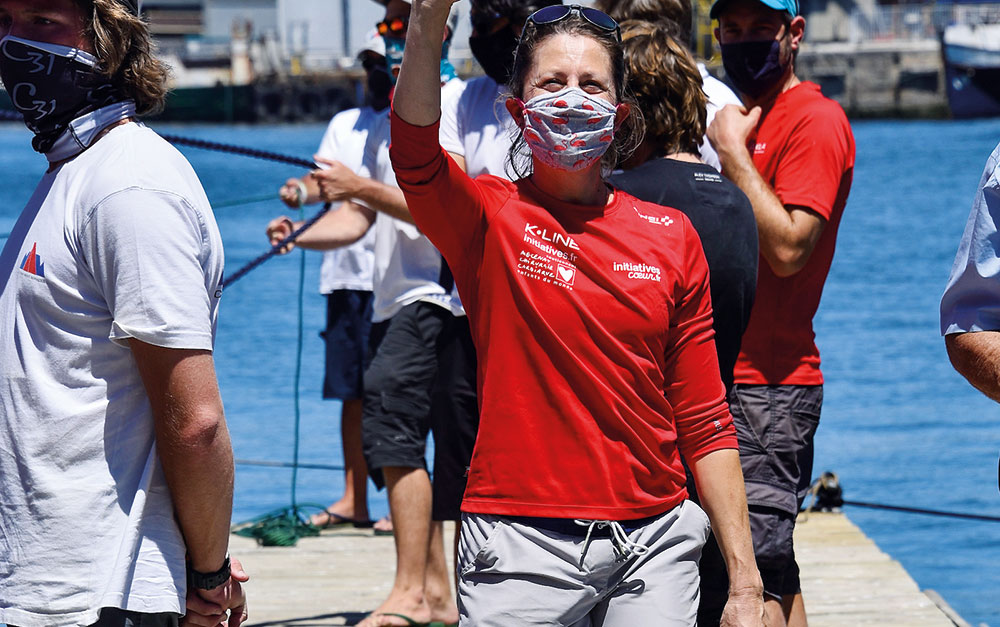The Vendée Globe is certainly not letting us down in terms of drama and excitement, reminding us why it is known as the Everest of the Seas.
We reported last month that Vendée Globe skipper Kevin Escoffier was rescued after his boat dramatically sank, but now we can bring you the full remarkable story in Kevin’s own words. The 35-year-old from Saint Malo had spent 11-and-a-half hours drifting in a liferaft before being picked up by 61-year-old five times Vendée Globe veteran Jean Le Cam.
Kevin had been racing in 5m waves and 25kt plus South Westerly winds when, after burying its nose in a wave, he was forced to swiftly abandon his boat, PRB, only to watch it break in two just two minutes later.
After his rescue Kevin said: “The boat folded up on a wave at 27kt. I heard a bang, but to be honest, I did not need to hear that to know what had happened. I looked at the bow. It was at 90 degrees. In a few seconds, there was water everywhere. The stern was under water and the bow was pointing up to the sky. The boat split in half in front of the mast bulkhead. It was as if she folded up.
“The electronics were burning. Everything went off. My only reflex was to grab my telephone to send the message and pick up the survival suit, which I never stow away. I wanted to pick up the grab bag, but I could not get to it with the water rising.
“I just had time to send a message to my team saying ‘I am sinking. I am not joking. MAYDAY’. Between the moment when I was out on deck trimming the sails and when I found myself in my survival suit, barely two minutes had passed. It all happened extremely quickly. I grabbed the liferaft at the stern.
“Close to the morning I heard a sail flapping so I got out, had my head out of the liferaft. Even with no sun we were able to see very well and I saw Jean (Le Cam) just above me. He threw me a line with a buoy at the end, which I caught. When I was close enough I jumped and caught the back of the boat. I said ‘I am sorry to disturb your race Jean.’ We had a big hug.”
Six days later Kevin Escoffier was successfully transferred from Jean Le Cam’s IMOCA to the Nivôse, a French Navy frigate. The race jury decided that Jean will receive a time compensation when he completes the race of 16hrs 15 mins.
Of the 33 IMOCAs which began the Vendée Globe from Les Sables-D’Olonne in France on 8 November, six have now officially retired: Nico Troussel (CORUM L’Épargne), Kevin Escoffier (PRB), Alex Thomson (HUGO BOSS), Sam Davies (Initiatives Coeur), Fabrice Amedeo (NEWREST – ART & FENÊTRES) and Sébastien Simon (ARKEA PAPREC).
The story of Alex Thomson’s retirement was reported last month but now British skipper Sam Davies (Initiatives Coeur) is out too leaving Pip Hare (15th) and Miranda Merron (23rd) flying the flag for the UK with, at the time of writing, Yannick Bestaven leading Charlie Dalin and Thomas Ruyant.
Sam Davies hit a UFO with the collision damaging the longitudinal framing which supports the keel of Initiatives Coeur.
Sam explained: “I was sailing at speeds between 15 and 22kts and I was actually just making a hot meal. I hit something. I did not see anything. I did not know what it was. But it was as if I had run aground on a rock at the time.
“The boat speed went from 20kts to zero. The boat nosedived on the impact with the keel. I knew it was the keel. I heard a crack coming from there. I and everything else flew forwards, including my dinner which has repainted the entire inside of my boat. But luckily I have just hurt some ribs.”
Sam made her way to Cape Town, but she says she is determined to return, after making repairs with her team and experts, to complete the race course as ‘hors course’, unclassified on the solo race which forbids any kind of outside assistance.
Sam said: “I have always said my mission is to sail around the world on this boat. For me, but also for Initiatives-Cœur, to support cardiac surgery for the kids. If I can fix the boat and go, I am motivated to do it. I have all the pieces and I have a great team. It will probably take time, it is a big job but I am very positive to give it a go as Isabelle Autissier* did.”
After announcing his retirement from the race last month, 19 days into the solo, non-stop, unassisted round-the-world yacht race Alex Thomson also made his way to Cape Town with irreparable rudder damage. It took the British skipper almost seven days to make the 1,800nm journey, sailing his IMOCA racing yacht with just one rudder.
Speaking in Cape Town Alex said: “I am certainly relieved to be back on dry land, but I have very mixed emotions. I am still coming to terms with what has happened, and I am obviously utterly devastated that this is how the race has ended for us. But, as I have said before, it is in our toughest moments that we find our greatest strength. Now we have to pick ourselves up and move forwards, and I have no doubt that we can do that together as a team. To everyone who has sent messages – a huge thank you.”
Also out of the race is Sébastien Simon. While in fourth place, and just after crossing the longitude of the Cape of Good Hope, Sébastien Simon’s Arkea Paprec collided with a UFO. He reported substantial damage to his starboard foil and its casing. He made his way to Cape Town to moor up near Alex Thomson and Sam Davies.
Ironically Cape Town is where the Vendée Globe started 34 years ago. In 1986, sailors in the BOC Challenge took a seat in a bar in Cape Town. Guy Bernardin, Bertie Reed and Philippe Jeantot talked of their dream to have a solo non-stop race around the world. The first Vendée Globe took place three months later.
This, the ninth edition of the iconic race, which takes place just every four years, has already seen a number of boats suffer technical failures, collisions or fall victim to the tropical storms and changing weather conditions.
The debate continues about the safety of sailors in the Vendée Globe. Already a number of skippers have reported hitting UFOs. But what is it they are hitting? There is no doubt that a great number of containers are lost in our oceans every year, but you would expect far worse damage to, for example, Sam Davies’s boat if that had been the case. Another possibility is tree trunks which are, perhaps surprisingly, very common. Fishing gear, as reported by Alex Thomson to be the cause of his rudder damage, is another problem. In reality, whatever the cause, it is debris that should not be in our seas which is impacting events like the Vendée Globe, but more importantly can be potentially very dangerous.
Many of the competing IMOCAs were fitted with a pioneering new electronic safety aid called OSCAR. Its aim is to prevent a collision with any of the many potential threats a vessel can encounter. Its effectiveness, presumably, will be assessed when the race is complete, but Sam Davies, for example, had it on board.
Before the race Kévin Escoffier said: “We have boats that go faster and faster, which means that in the event of a collision there are more consequences. Also, our boats have become wider and wider with the foils, increasing the chances of hitting something, so if there is a system that can reduce the chances of a collision then we must have it on board.”
So far the rate of retirements – at six out of 33 – has been very small compared to historical levels, when up to 50 per cent of the fleet has failed to finish. In the last race, at the same stage, 11 boats out of the 29 starters had retired. in the race before that, 8 of the 20 starters had dropped out. So far, of the six boats that have retired only three have done so as a result of collision damage (HUGO BOSS, Initiatives-Coeur, ARKEA PAPREC). Several other boats have suffered damage as a result of collisions, but have managed to continue in reasonably competitive shape.
The other retirements have been caused by dismasting (CORUM L’Epargne), computer failure and other issues (Newrest-Art & Fenêtres) and a total boat loss in the case of PRB.
Is the combination of speed and UFOs leading to the boat failures or are the designs simply not up to the pressures that nature puts on them? Is it a coincidence that the six boats that have, so far, retired are all foilers?
As the race and boat analysis continues hopefully the answers to these questions will become clearer, but in the meantime what are your thoughts? Post a comment at the All at Sea Facebook page (www.facebook.com/allatseanewspaper) or send us an email at editor@allatsea.co.uk.
Turn to page 17 to read David Henshall’s in-depth analysis of high speed foilers.
* Isabelle dismasted in the 1992 BOC Challenge but repaired to become the first woman to complete a solo round-the-world circuit.




















